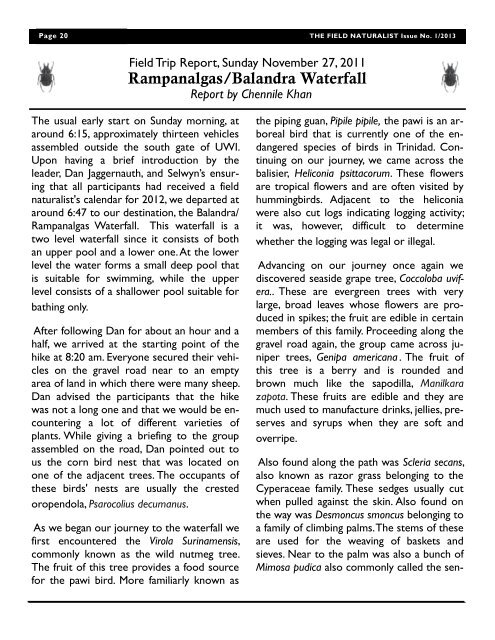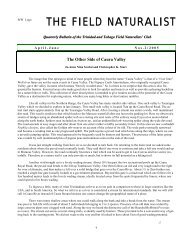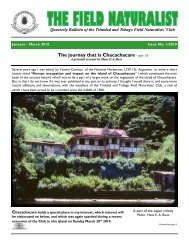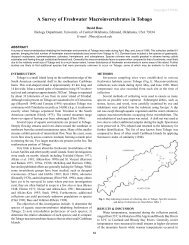Vol 1 - The Trinidad and Tobago Field Naturalists' Club
Vol 1 - The Trinidad and Tobago Field Naturalists' Club
Vol 1 - The Trinidad and Tobago Field Naturalists' Club
You also want an ePaper? Increase the reach of your titles
YUMPU automatically turns print PDFs into web optimized ePapers that Google loves.
Page 20 THE FIELD NATURALIST Issue No. 1/2013<strong>Field</strong> Trip Report, Sunday November 27, 2011Rampanalgas/Bal<strong>and</strong>ra WaterfallReport by Chennile Khan<strong>The</strong> usual early start on Sunday morning, ataround 6:15, approximately thirteen vehiclesassembled outside the south gate of UWI.Upon having a brief introduction by theleader, Dan Jaggernauth, <strong>and</strong> Selwyn’s ensuringthat all participants had received a fieldnaturalist's calendar for 2012, we departed ataround 6:47 to our destination, the Bal<strong>and</strong>ra/Rampanalgas Waterfall. This waterfall is atwo level waterfall since it consists of bothan upper pool <strong>and</strong> a lower one. At the lowerlevel the water forms a small deep pool thatis suitable for swimming, while the upperlevel consists of a shallower pool suitable forbathing only.After following Dan for about an hour <strong>and</strong> ahalf, we arrived at the starting point of thehike at 8:20 am. Everyone secured their vehicleson the gravel road near to an emptyarea of l<strong>and</strong> in which there were many sheep.Dan advised the participants that the hikewas not a long one <strong>and</strong> that we would be encounteringa lot of different varieties ofplants. While giving a briefing to the groupassembled on the road, Dan pointed out tous the corn bird nest that was located onone of the adjacent trees. <strong>The</strong> occupants ofthese birds' nests are usually the crestedoropendola, Psarocolius decumanus.As we began our journey to the waterfall wefirst encountered the Virola Surinamensis,commonly known as the wild nutmeg tree.<strong>The</strong> fruit of this tree provides a food sourcefor the pawi bird. More familiarly known asthe piping guan, Pipile pipile, the pawi is an arborealbird that is currently one of the endangeredspecies of birds in <strong>Trinidad</strong>. Continuingon our journey, we came across thebalisier, Heliconia psittacorum. <strong>The</strong>se flowersare tropical flowers <strong>and</strong> are often visited byhummingbirds. Adjacent to the heliconiawere also cut logs indicating logging activity;it was, however, difficult to determinewhether the logging was legal or illegal.Advancing on our journey once again wediscovered seaside grape tree, Coccoloba uvifera..<strong>The</strong>se are evergreen trees with verylarge, broad leaves whose flowers are producedin spikes; the fruit are edible in certainmembers of this family. Proceeding along thegravel road again, the group came across junipertrees, Genipa americana . <strong>The</strong> fruit ofthis tree is a berry <strong>and</strong> is rounded <strong>and</strong>brown much like the sapodilla, Manilkarazapota. <strong>The</strong>se fruits are edible <strong>and</strong> they aremuch used to manufacture drinks, jellies, preserves<strong>and</strong> syrups when they are soft <strong>and</strong>overripe.Also found along the path was Scleria secans,also known as razor grass belonging to theCyperaceae family. <strong>The</strong>se sedges usually cutwhen pulled against the skin. Also found onthe way was Desmoncus smoncus belonging toa family of climbing palms. <strong>The</strong> stems of theseare used for the weaving of baskets <strong>and</strong>sieves. Near to the palm was also a bunch ofMimosa pudica also commonly called the sen-








